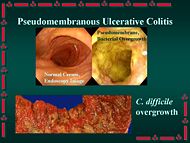Pseudomembranous enterocolitis: Difference between revisions
Jump to navigation
Jump to search
imported>Robert Badgett |
imported>Robert Badgett (Infobox with picture from c diff article) |
||
| Line 1: | Line 1: | ||
{{Infobox_Disease | | |||
Name = Pseudomembranous enterocolitis | | |||
Image = Img1.jpg| | |||
Caption = Pseudomembranous enterocolitis| | |||
DiseasesDB = | | |||
ICD10 = | | |||
ICD9 = | | |||
MeshID = D004761| | |||
OMIM = | | |||
MedlinePlus = | | |||
}} | |||
In [[medicine]], '''pseudomembranous enterocolitis''' is an "acute inflammation of the intestinal mucosa that is characterized by the presence of pseudomembranes or plaques in the small intestine (pseudomembranous enteritis) and the large intestine (pseudomembranous colitis). It is commonly associated with [[antibiotic]] therapy and [[clostridium difficile]] colonization."<ref>{{MeSH}}</ref> | In [[medicine]], '''pseudomembranous enterocolitis''' is an "acute inflammation of the intestinal mucosa that is characterized by the presence of pseudomembranes or plaques in the small intestine (pseudomembranous enteritis) and the large intestine (pseudomembranous colitis). It is commonly associated with [[antibiotic]] therapy and [[clostridium difficile]] colonization."<ref>{{MeSH}}</ref> | ||
Revision as of 13:00, 28 January 2009
| Pseudomembranous enterocolitis | |
|---|---|
| Pseudomembranous enterocolitis | |
| MeSH | D004761 |
In medicine, pseudomembranous enterocolitis is an "acute inflammation of the intestinal mucosa that is characterized by the presence of pseudomembranes or plaques in the small intestine (pseudomembranous enteritis) and the large intestine (pseudomembranous colitis). It is commonly associated with antibiotic therapy and clostridium difficile colonization."[1]
Treatment
Antibiotics
Various antibiotics have been studied.[2][3]
Administration of bacteria
Priobiotic administration may[4] or may not [5]help according to a meta-analyses and a more recent randomized controlled trial.[6]
Rectal infusion of feces helped in a case report.[7]
References
- ↑ Anonymous (2024), Pseudomembranous enterocolitis (English). Medical Subject Headings. U.S. National Library of Medicine.
- ↑ Nelson R (2007). "Antibiotic treatment for Clostridium difficile-associated diarrhea in adults". Cochrane Database Syst Rev (3): CD004610. DOI:10.1002/14651858.CD004610.pub3. PMID 17636768. Research Blogging.
- ↑ Wenisch C, Parschalk B, Hasenhündl M, Hirschl AM, Graninger W (May 1996). "Comparison of vancomycin, teicoplanin, metronidazole, and fusidic acid for the treatment of Clostridium difficile-associated diarrhea". Clin. Infect. Dis. 22 (5): 813–8. PMID 8722937. [e]
- ↑ McFarland LV (April 2006). "Meta-analysis of probiotics for the prevention of antibiotic associated diarrhea and the treatment of Clostridium difficile disease". Am. J. Gastroenterol. 101 (4): 812–22. DOI:10.1111/j.1572-0241.2006.00465.x. PMID 16635227. Research Blogging.
- ↑ Pillai A, Nelson R (2008). "Probiotics for treatment of Clostridium difficile-associated colitis in adults". Cochrane Database Syst Rev (1): CD004611. DOI:10.1002/14651858.CD004611.pub2. PMID 18254055. Research Blogging.
- ↑ Klarin B, Wullt M, Palmquist I, Molin G, Larsson A, Jeppsson B (September 2008). "Lactobacillus plantarum 299v reduces colonisation of Clostridium difficile in critically ill patients treated with antibiotics". Acta Anaesthesiol Scand 52 (8): 1096–102. DOI:10.1111/j.1399-6576.2008.01748.x. PMID 18840110. Research Blogging.
- ↑ Schwan A, Sjölin S, Trottestam U, Aronsson B (October 1983). "Relapsing clostridium difficile enterocolitis cured by rectal infusion of homologous faeces". Lancet 2 (8354): 845. PMID 6137662. [e]
